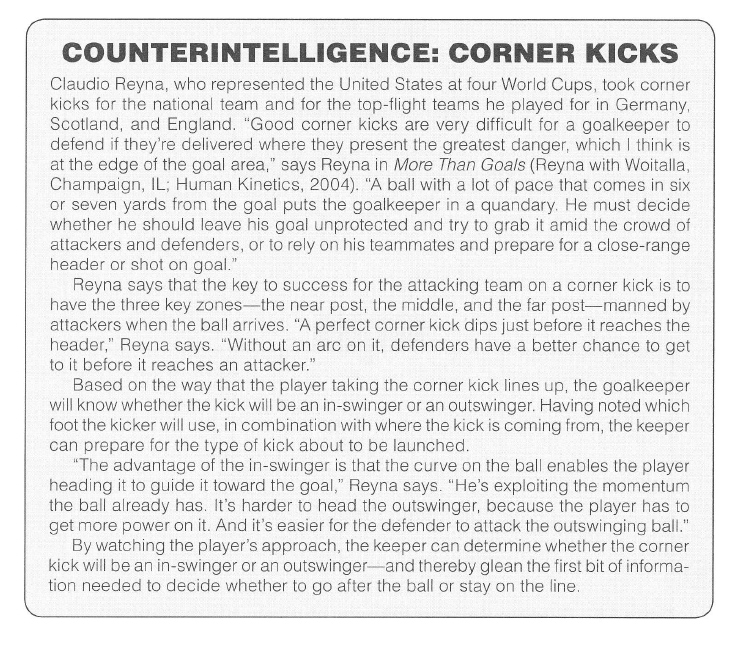| Ready? Set Play!
chapter from The Complete Soccer Goalkeeper
Whether it's a free kick (and the wall needs to be set up) or a corner kick (and the defense needs to be positioned properly), the keeper must be calm, composed, and clear about what he wants his teammates to do in response to the call. The keeper's ability to quickly organize the team will play a major role in whether or not a goal is conceded. In today's game, players have the ability to curve a ball over the wall and to serve in a dangerous free kick that can be directed into the net off a foot or head. Before the restart, the keeper must be sharp and alert—and must be ready to eliminate as much of the risk of a goal being scored as possible. How does a keeper limit the opponent's chances of scoring on set plays? He works on these plays during training and talks about them in team meetings. He rehearses where players need to be, the vocabulary that will be used, the roles that certain players will have, and the position that he will take up in the goal. The keeper must assess the danger of free kicks that are within shooting distance and must set up a wall of teammates to protect the goal. He must provide the leadership that his defenders need to cope with free kicks and corner kicks that may be launched into the danger zone. As soon as the referee blows the whistle to acknowledge a foul, the keeper must immediately begin to analyze the situation. This is not a time to argue a call or to blame a teammate. It is simply a time to begin eliminating the chance of a goal being scored. The first order of business is to judge whether the infraction is in an area that will allow for a strike on goal. Let's assume that it is within shooting distance of the goal and presents the opposition with a goal-scoring opportunity. The keeper must now organize the team accordingly. The next job is to call for the number of players that will make up the wall. The keeper must be very clear, loud, and confident in announcing the desired number. This number will be based on several factors: • Where the ball is located and at what distance from the goal The more central the location of the free kick, the more defenders the keeper should place in the wall (see figure 9.1). In most cases, the total will not be less than two and will not exceed five. If the free kick is from fairly wide and the opponent brings only one player to the ball—and if the player is positioned for an outswinger—the defense may be able to defend the free kick with only one player. Players should practice and review the building of walls of assorted sizes so that the players know which players will assume which positions. 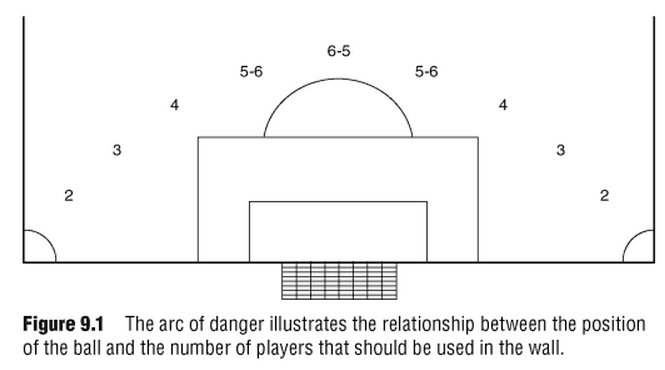 Wall-Worthy Players The players who will be included in the wall and the order of those players in the wall should be determined at practice sessions and in pregame meetings. Going into the game, the keeper should know exactly which players will be used in all the possible free-kick situations that require a wall. 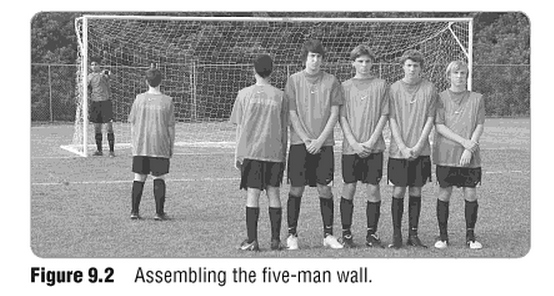 The first player in the wall needs to be someone who is usually on the field (a 90-minute player). In addition, this player should be someone who plays in a central location and can quickly take his place in the wall. Starting the wall with the same player ensures continuity between the keeper and the wall setup. The wall will always be built off this first player, so the player must have a good understanding of what the keeper wants. That is why this player should be a constant in the number one position. He should turn his body to face the keeper so the keeper can guide him to the appropriate position. The keeper should set up this one player and then concentrate on the shooter. The keeper needs to place the first player a full body width off the near post. Having this player overlap the post by the full width of his body rather than align between the near post and the ball will prevent the ball from being curved around the wall and into the near post. As players 2, 3, and 4 are added to the wall, the height of the wall should increase. Players 2 and 3 should be the tallest so that they will hinder a shooter from going over the top of the wall to the near post. Player 5 should also be tall enough to help prevent a ball from being curled into the upper corner off the far post. All these players need to have the courage to take a shot off their body to prevent a goal. The wall needs to start about 8 to 10 yards away from the free kick. Any closer and the official will back the wall up, changing the angle of the wall. Bullet Player Because the wall is not an invincible barrier, the keeper's team should have an extra player or two at the ready (see figure 9.3). 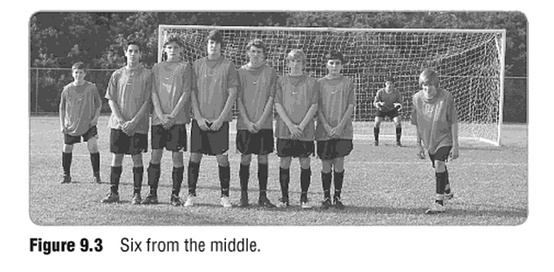 The bullet player sets up off the last player in the wall (i.e., player 5) he's not lined up in the wall but just off the last member of the wall. The bullet player's job is to block or disrupt the free kick. This player should move toward the ball at an angle that allows a window between the keeper and player 5. His approach to the shooter should eliminate a shot directly to the back post. The bullet player must have the speed to quickly close the distance to the shot, and he must have the courage to go straight at the ball as it is kicked. This player truly must take one for the team. Weak-Side Cover As the wall is being constructed, I prefer to have a player (usually a forward) stand behind the ball and adjust the wall for the keeper. This allows the keeper to set player 1 and then concentrate solely on the shooter. Once the wall is in place (see figure 9.3), this player covers the weak side or near-post side of the wall. Many opposing teams will run a player over the ball to the near post. If that area is not covered, the opponent will be able to play him in for a chance at goal. The weak-side cover player sets up off the shoulder of player 1. He protects that area and looks to clear a rebound after the shot. Once a foul is called, the keeper must spring in to action—not in a chaotic way, but in a professional manner. The keeper has to maintain and project an attitude that everything is OK and under control. The keeper calls out a number for the wall, sets up the first player, and takes up a position in the goal. Where is that position? This will depend on various factors, including how far away the ball is from the goal and whether it is left or right of center. The keeper needs to be only about a yard off the goal line. She needs as much time as possible to read and react to the shot. This starting position will allow her to have that time. The keeper should be off the shoulder of the last player in the wall and should view the shot by looking between the last wall player and the bullet player. Near Post-Far Post Whether the ball is hit over the wall to the near post or hit toward the back post to the keeper's side of the wall, the keeper should make an attempt to save the shot. This is why the keeper plays off the last player in the wall; this position gives the keeper the best chance of saving a shot hit over the wall as well as one sent to the back post. Shots that are hit over the wall toward the near post are difficult for the keeper for several reasons: • These shots are usually curving away from the keeper. Shots hit to the back post are usually hit with great pace, so the keeper faces the challenge of saving a ball hit with tremendous speed. Importance of Scouting Video offers the advantage of allowing coaches and keepers to view numerous free kicks from the opponents so they can spot tendencies. They can also pause and rewind to check for helpful clues. Scouting the opposition gives the keeper insight on where players are likely to put balls in specific situations. Should the keeper expect a right-footed or left-footed shot? Will a free kick likely be bent back over the wall or struck to the back post? Will the opposition use some form of deception to distract the keeper and the team? All these questions can be answered by studying the opponent. The keeper needs to be fully familiar with a team's tendencies before facing them on the field in order to make the proper decisions and plays. A keeper should never be surprised by the way a team attacks a free kick. When Opponents Meddle There is much debate regarding the best way to deal with players joining the wall. One idea is to put your players directly behind the attacking players in the wall. This is done in case the ball is purposely shot at the opponent's players in the wall, who then move in time for the ball to scream past them and into the net—in this scenario, the attacking players in the wall shield the keeper until the last split second. With defensive players behind the opponents, a ball sent toward an attacking player who breaks away from the wall would hit off the keeper's team and away from the goal. Another strategy is to keep your wall small if you know that your opponent is going to add players. This prevents the possibility of winding up with an eight- person wall when the other team adds players. The reasoning here is that even though fewer players are in the wall, the keeper's ability to see the shot—which is the most important thing—is not compromised. In 2008,1 had the honor of being the goalkeeper coach for the U.S. Olympic team. Having defeated Japan, we faced the highly talented and favored Netherlands in our second game. After falling behind 1-0, we came back to take the lead 2-1 well into stoppage time. A foul was called against us, and a free kick from just outside the penalty area was awarded. This was the precise moment that our team's experience at the Olympic Games took a turn for the worse. The foul occurred just outside the penalty area, to the right of our goalkeeper, Brad Guzan. This was a very dangerous position for a foul and presented a clear opportunity for the Netherlands. Brad did an excellent job of remaining calm and organizing a five-man wall, along with proper weak-side coverage as well as a bullet player. In a prematch meeting, we coaches had told our team that if the players who formed the wall were going to jump, they must not jump to a height at which a ball could go in underneath the wall. The Dutch player Gerald Sibon lined up to take the free kick. He is a powerful and experienced striker. As Sibon ran up to the ball to shoot, our wall players jumped too high, and the ball went underneath the wall and into the goal. Brad had no chance to react to it. Instead of winning 2-1 and clinching second-round passage, we finished the game in a 2-2 draw, and we were eliminated after our third group game. Several aspects of this painful experience can be debated. Should players in a wall jump? Is there an advantage to jumping? The answers to these questions are not absolute. In most cases, if the wall players are going to jump, they must make a unified effort not to allow the ball to slip underneath the wall. The most important thing is to wait until the ball is struck before jumping. The advantage to jumping is that the wall players may deflect a shot that is hit over the wall and is on its way into the goal. One consideration that should never be overlooked when deciding whether to jump is the qualities of the player taking the free kick. If the player is skillful and hits the ball consistently over the wall, you may want to have the wall players jump. In the case of the Olympics, the player taking the kick was powerful and could be counted on to hit the ball with pace. When defending against this type of player, it may be beneficial for the wall players to stay on the ground, preventing a powerful shot from going through or under them. In today's game, service from the wide channels of the field has become an art. These are the balls that can curl into the box and, even if they are not touched, bounce into the goal. On set plays, balls launched from a wide field position are usually in-swingers. This kind of service can be very dangerous for the keeper. Teams serving in-swingers may bring their big players forward to create a very difficult defensive situation for the keeper. In this situation, the keeper must take a position in the middle area of the goal in order to attempt to cover both the near and far post. The keeper should be no more than a yard or two off the line. This conservative approach gives the keeper more time to react to the service, especially if it is coming through a crowd. Some goalkeepers shift to the near post when they see opposing players making hard runs there. Keepers need to be disciplined and hold their position until the ball is served to avoid being duped by fakes and feints. Depending on the location and distance of the wide free kick, the keeper should make sure that she has as much room as possible to come off the line— and to see the ball clearly. In most cases, this means that keepers will have their teammates begin defending from the 12- to 18-yard line. This gives the keeper plenty of room and time to make a play. Some keepers who are very quick and strong in the air may push their defending line as high as the 18-yard line. The keeper should communicate the desired defending spots as soon as the foul is given. The defending team needs to hold the line and not allow the opponent to get in deep. Once keepers decide where they want their defenders when defending a wide free kick, they must decide whether they want the defenders to use man-to-man or zone marking. The advantage of man-to-man is that everyone has a clear assignment. Using a two-player wall may force opponents to use a wider service. When defending a free kick from the flank, most teams also keep a free player in the "hole." This player is usually in line with the near post. The positioning of this player counteracts the risk of a dangerous ball being whipped into the near post. The five man markers begin from the 16 to 18 yard line to give the keeper room to come off the line. Defenders need to fight through screens and picks to stay with their players. See figure 9.4 for an example of man-to-man defense in this situation. I prefer man-to-man marking in these situations because a zone defense requires sophisticated synchronization between defenders and creates too many opportunities for attackers to lose their markers. If the team chooses zone covering, then the players need to have proper spacing (two to three yards) across the back and must not allow players to run through. When using a zone defense, the setup and coverage for the players on the ball and for the free player are the same as for man-to-man. The wall defenders (X4 to X8 ) begin from a predetermined line and space themselves to prevent penetration; then they defend their assigned area. 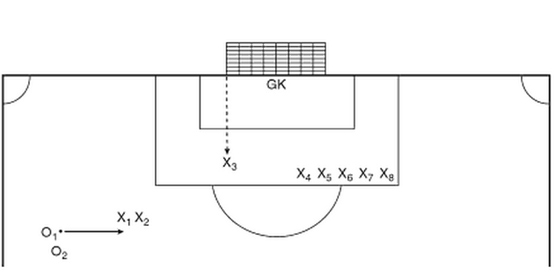 Figure 9.4 Defending against a wide free kick. If the second player on the ball at the kick (02) runs over the ball down the wing, the first defender on the ball at the kick (X) follows,and X2 adjusts accordingly. Post Players An effective strategy is to have players on both posts during a corner kick. Too often, goals are conceded that would have been prevented if players were stationed at either post—players who could have cleared the ball to safety. The post players will be most effective if they're standing with their weaker leg next to the post. In this position, the player's dominant leg is protecting more of the goal. For example, the player on the goalkeeper's right would be a left-footer—or at least a player with a strong left foot. This is a small detail that can make a big difference. Poor clearances after corner kicks often lead to goals. If the post player must clear the ball, the player should use the stronger foot. The players whom the keeper orders to the posts will not be the biggest, best jumpers. Those players are needed to mark up and battle the attackers. The post players must be alert and have good, quick reactions. The post players leave their stations only after the ball is cleared and the keeper has given them the instruction to "get out." Free Players The next area that needs to be covered, or zoned, is the near post at the 6-yard line. Many teams attack this area. Putting a free player in this location (X3, in figure 9.5a and 9.5b) helps eliminate this option for the attacking team. This player must be good in the air and must be smart enough to pick up players running in front of her. Some teams also put a zonal or free player in the middle of the goal at the edge of the goal area (X3 in figure 9.5a). This is done if the keeper's team is playing against a particularly dangerous set-play team, if the keeper has difficulty winning high balls in that area, or if the opposition sends only four players to the goal area. This player should be able to dominate in the air and should be very aggressive. Having a player in this position gives the keeper extra security, but it does make for a crowded penalty area. 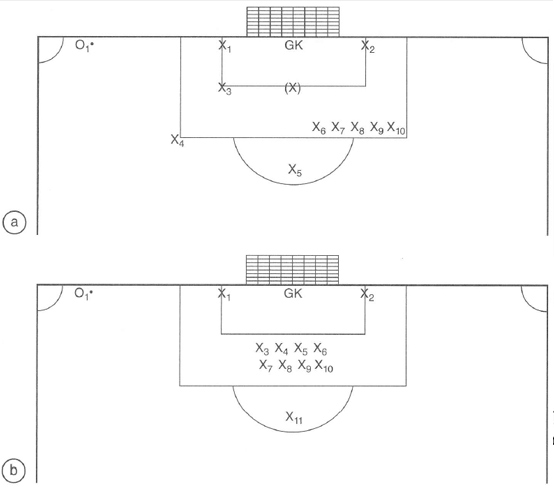 (b) zone coverage. All players come back to the goal area to provide maximal coverage. Man Markers The next set of players—after the post players and the one or two free players—are the man markers. These players need to be combative and good in the air. They should be matched up with opposing players according to height, strength, and athletic ability. These players need to have a high level of concentration to stay with their player once the ball is served. Full Cover The defending team must also cover the area at the top of the penalty area. Balls that get cleared out may fall in this area, and defenders must be there to pick up the scraps and not allow a strike on goal. Also, opponents may run a play where the ball is served to the top of the penalty area, and defenders in that area (X4 and X5 in figure 9.5a) can eliminate the danger. These defenders can also serve as an outlet for the keeper once he claims the ball and starts the attack. Because very little time lapses between the corner-kick service and the arrival of the ball in front of the goal, the opponent's key attackers are usually marked man-on-man. Defending with a pure zone defense on a corner kick is likely to allow the attackers too much space as the defenders sort out who's marking whom. Teams that opt to use zone coverage must make sure the defenders are spaced close together and totally aware of when an opponent comes into their zone and must be covered. Coping With a Keeper Menace Not surprisingly, the keeper often becomes preoccupied with the presence of the distracting player. Young keepers often get provoked into pushing and jostling for position. That's taking the bait. It's exactly what the opponent wants the keeper to do. Getting into a shoving match takes the keeper's focus away from the ball and the task of organizing the defenders. In fact, this menacing player can be dealt with quite easily. The keeper should know in advance (thanks to scouting) that this player will be there. As a result, the keeper will be mentally prepared. The keeper should direct a teammate to mark this player man-to-man. The key to this tactic is the teammate's starting position. The defensive player needs to be on the outside of the opponent—not between him and the goal. When the marking player is to the outside, this sandwiches the menacing player between the marker and the keeper, making it difficult for him to receive a direct ball. Also, having the marking player on the outside gives the keeper the room and space to come off the line. Short-Corner Defending In general, if the opposition sends two players out to take the corner, then the defending team needs to send two players along with them. Which players go out to defend the short corner kick depends on each team's organization. Some teams have players leave the near post and top of the penalty area (players X1 and X4 in figure 9.6) to cover it. Regardless of which players are selected to diffuse the situation, the defense needs to have even numbers with the opponent. Keepers need to be clear before the match on how they want short corner kicks defended. They also need to be able to adapt to a change if necessary. The positioning of the keeper will change with the moving and playing of the ball. Set pieces decide games at all levels. Keepers need to constantly rehearse defending set plays on the training ground. Set plays also need to be discussed and analyzed in video sessions and meetings. Scouting is an important component to defending and preventing goals on set pieces. Keepers must have thorough knowledge about where an opponent tends to attack on a corner kick and where a player is likely to shoot on a free kick. With this information, the keeper can organize the defenders with confidence. Composure, communication, organization, fundamental skills, and experience in confronting set plays are the ingredients to preventing free kicks and corner kicks from turning into goals. Teams should design their strategy for defending set plays based on the comfort and characteristics of the keeper and the team. |
|
|




